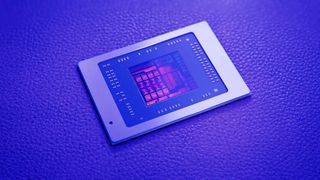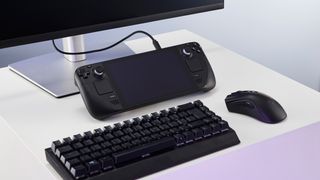AMD's PS5-like APU is reportedly getting 16 full-fat Zen 5 cores
Dr. Su is basically asking whether you REALLY need a discrete graphics card in your next gaming laptop.

The Ryzen 8000-series CPUs are shaping up to redefine both handhelds and gaming laptops, and the latest rumours suggest a mix of both chiplet, full-fat Zen 5, and Zen 5c cores going into them. That, and there's that monstrous integrated graphics core which is promising to be the gaming laptop chip we've been waiting for.
But as much as the Steam Deck is lauded as the device that made handheld gaming PCs a genuine 'thing', it's AMD's continued APU passion projects that have helped them evolve. The ROG Ally wouldn't have been possible without AMD's Z1 Extreme APU, and the raft of Ryzen 7 7840U-based handhelds following would have struggled without the exceptional red team silicon.
And that silicon lineage is only set to continue. Likely built with an eye on the handheld market is the AMD Strix Point chip, which is now rumoured to come sporting four full Zen 5 processor cores but also a healthy complement of Zen 5c cores, too. That means you can expect a 12-core, 24-thread APU at the heart of the next-gen handhelds coming out in 2024-25.
And if you have any concerns over that Zen 5c silicon just being the same sort of lowly, slightly second-rate core design as Intel's Efficient cores, well, the AMD version of Efficient cores are very different beasts. They've got all the good stuff, though with less cache, and come in a far smaller footprint compared to the non-c cores.
Because they're designed to go in power-constricted chassis, the fact they're only made for relatively low clock speeds works just fine in that environment.
We'll see them first as Zen 4c cores in the upcoming Phoenix 2 chips, but those are seemingly an test run for Strix Point. Which, in short, is going to deliver more multi-threaded performance than you could possibly need in such a small 28W+ form factor.


Steam Deck review: Our verdict on Valve's handheld.
Best Steam Deck accessories: Get decked out.
Steam Deck battery life: What's the real battery life?
It's only full-fat cores for the big boi APU, however, as Strix Halo is going to get the full multi-chiplet complement of 16 Zen 5 cores. SIXTEEN cores in an APU. That means a total of 32 threads of high-end computing power in a super-powerful mobile chip. But those aren't the numbers that get this PC nerd excited, because it's the 40 compute units of RDNA 3.5 GPU silicon that has my interest very much piqued.
The biggest gaming news, reviews and hardware deals
Keep up to date with the most important stories and the best deals, as picked by the PC Gamer team.
That's the same CU count as a Radeon RX 6750 XT, and that means genuine gaming performance. Notably, genuine gaming performance without a discrete graphics card. That brings with it the possibility of both unprecedented performance from thin and light laptop form factors, and with a proposed peak TDP of 120W potentially not a little gaming battery life, too.
The expectation is that the Strix Halo APU will primarily find its way into laptops—I'm imagining the next generation of Framework 13 mainboard with serious gaming performance here—but also for seriously small form factor, NUC-like machines. Maybe Intel saw the writing on the wall, and that's why it got out of the NUC business sharpish.
This is effectively the sort of APU that's made both the PlayStation 5 and Xbox Series X such powerful games consoles. It seems rather strange that it's taken so long for AMD to get around to delivering the sort of APU we know they're capable of, but the Strix Halo chip reportedly arriving at the end of next year will be that processor.

Dave has been gaming since the days of Zaxxon and Lady Bug on the Colecovision, and code books for the Commodore Vic 20 (Death Race 2000!). He built his first gaming PC at the tender age of 16, and finally finished bug-fixing the Cyrix-based system around a year later. When he dropped it out of the window. He first started writing for Official PlayStation Magazine and Xbox World many decades ago, then moved onto PC Format full-time, then PC Gamer, TechRadar, and T3 among others. Now he's back, writing about the nightmarish graphics card market, CPUs with more cores than sense, gaming laptops hotter than the sun, and SSDs more capacious than a Cybertruck.
Most Popular






